How to determine the cross-section of a wire by diameter and vice versa: ready-made tables and calculation formulas
Wires are widely used in the field of electrical networks for various purposes. At first glance, the transportation of energy through cable and wire products seems simple and straightforward.
However, to ensure the safe operation of electrical wiring, it is necessary to take into account a number of important nuances in the design and construction of electrical networks. One of these details is the ability to correctly calculate the cross-section of the wire by diameter, because the boundary of the permissible current passing through the conductor depends on the accuracy of the determination.
How to determine the cross section or diameter, is there a difference between these parameters? We will try to understand the article. In addition, we have prepared summary tables that will help you choose a conductor depending on the conditions of installation of the electrical network, the material for manufacturing the cable core and the power characteristics of the connected units.
The content of the article:
The need and procedure for the calculation
A variety of equipment with different capacities is powered by electric current. And the range of capacities is very extensive.
Each individual electrical apparatus represents a load, depending on the magnitude of which a current of a certain strength is required.

The required amount of current for the required load can be passed through wires of different diameters (cross-sections).
But in conditions of insufficient conductor cross-section for the passage of a given volume of current, the effect of increased resistance arises. As a result, heating of the wire (cable) is noted.
If you ignore this phenomenon and continue to pass current, there is a real danger of heating up to the moment of ignition. This situation threatens with a serious emergency.That is why the calculations and selection of current transfer circuits to the load require special attention.

The correct calculation, competent selection cables and wires positively affects the operation of equipment acting as a load.
So, in addition to the safety factor, the calculation of the cross-sections of the electric cable by diameter or vice versa is a mandatory action from the point of view of ensuring the efficient operation of electric machines.
Determination of the conductor core diameter
Actually, this operation can be performed by simple linear measurement. For accurate measurement, it is recommended to use a point instrument, for example, a vernier caliper, or even better, a micrometer.
A relatively low result in accuracy, but quite acceptable for many applications of wires, gives a diameter measurement with an ordinary ruler.

Of course, the measurement should be carried out in a state of a bare conductor, that is, previously the insulation coating is removed.
By the way, an insulating coating, for example, of a copper wire, is also considered a thin layer of varnish spraying, which also needs to be removed when a very accurate calculation is required.
There is a “household” method for measuring diameter, suitable in cases where there are no point measuring instruments at hand. To apply the method, an electrician’s screwdriver and a school ruler are required.
The conductor for measurement is preliminarily stripped of insulation, after which it is wound tightly round to round on the screwdriver bar. Usually a dozen turns are wound - a convenient number for mathematical calculations.
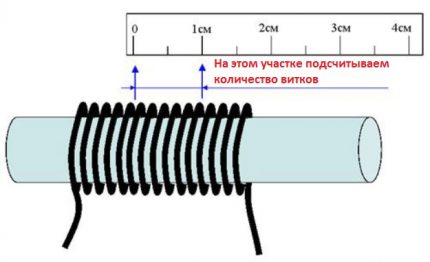
Next, the coil wound on the screwdriver rod is measured with a ruler from the first to the last turn. The resulting value on the line must be divided by the number of turns (in this case, 6). The result of such a simple calculation will be the diameter of the wire core.
Calculation of the cross section of the electric wire
To determine the value of the cross section of the conductor core, you will have to use the mathematical formulation.
In fact, the cross section of the conductor core is the cross-sectional area - that is, the area of the circle. The diameter of which is determined by the method described above.
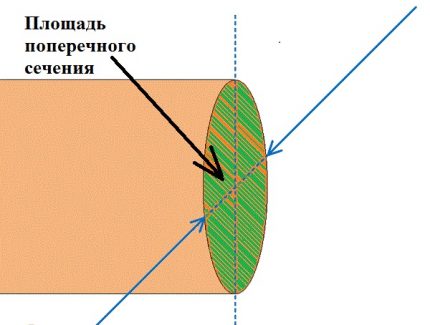
Based on the diameter value, it is easy to obtain the radius value by dividing the diameter in half.
Actually, you need to add the π constant (3.14) to the data obtained, after which you can calculate the cross section value using one of the formulas:
S = π * R2 or S = π / 4 * D2,
Where:
- D - diameter;
- R - radius;
- S - transverse section;
- π Is a constant corresponding to 3.14.
These classical formulas are also used to determine the cross section of stranded conductors. The calculation strategy remains virtually unchanged, with the exception of some details.
In particular, the cross section of one core from the beam is initially calculated, after which the result is multiplied by the total number of wires.

Why should be considered an important factor section determination? The obvious point, connected directly by the Joule-Lenz law, is because the parameter of the cross section of the conductor determines the boundary of the permissible current flowing through this conductor.
Sectional diameter determination
It is permissible by mathematical calculation to determine the diameter of the conductor core when the section parameter is known.
This, of course, is not the most practical option, given the availability of simpler methods for determining the diameter, but the use of this option is not excluded.
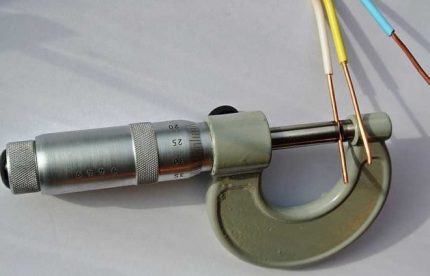
To perform the calculation, you will need virtually the same numerical information that was used to calculate the cross section using a mathematical formula.
That is, the constant "π" and the value of the area of the circle (section).
Applying these formula values below, the diameter value is obtained:
D = √4S / π,
Where:
- D - diameter;
- S - transverse section;
- π Is a constant corresponding to 3.14.
The application of this formula may be relevant when the section parameter is known and there are no suitable tools for measuring the diameter at hand.
The cross-section parameter can be obtained, for example, from the documentation for the conductor or from the table for calculations, where the most commonly used classic options are presented.
Tables for choosing a suitable conductor
A convenient and practical option for selecting the desired wire (cable) is the use of special tables, which indicate the diameters and cross-sections relative to the power and / or conducted currents.
Having such a table at hand is an easy and simple way to quickly determine the conductor for the required electrical installation.

Given that traditional conductors of electrical installation are products with copper or aluminum conductors, there are tables for both types of metals.
Also, tabular data often presents values for voltages of 220 volts and 380 volts. Plus, the values of the installation conditions are considered - closed or open wiring.
In fact, it turns out that on one sheet of paper or on a picture downloaded to a smartphone contains voluminous technical information that can do without the mathematical (linear) calculations noted above.
Moreover, many manufacturers of cable products, in order to simplify the choice of the necessary conductor for the buyer, for example, for installing outlets, offer a table in which all the necessary values are entered.
It remains only to determine what load is planned for a particular electric point and how the installation will be performed, and based on this information, select the correct wire with copper or aluminum conductors.
Examples of such options for calculating the diameter of the wire over the cross section are given in the table, where the options for copper and aluminum conductors are considered, as well as ways to lay the wiring - open or hidden type. From the first table you can determine the indicator power and current sections.
Correspondence table for the diameter of copper and aluminum conductors depending on installation conditions
| Power, W | Current, A | Copper conductor core | Aluminum conductor core | ||||||
| Open type | Closed type | Open type | Closed type | ||||||
| S mm2 | D mm | S mm2 | D mm | S mm2 | D mm | S mm2 | D mm | ||
| 100 | 0,43 | 0,09 | 0,33 | 0,11 | 0,37 | 0,12 | 0,40 | 0,14 | 0,43 |
| 200 | 0,87 | 0,17 | 0,47 | 0,22 | 0,53 | 0,25 | 0,56 | 0,29 | 0,61 |
| 300 | 1,30 | 0,26 | 0,58 | 0,33 | 0,64 | 0,37 | 0,69 | 0,43 | 0,74 |
| 400 | 1,74 | 0,35 | 0,67 | 0,43 | 0,74 | 0,50 | 0,80 | 0,58 | 0,86 |
| 500 | 2,17 | 0,43 | 0,74 | 0,54 | 0,83 | 0,62 | 0,89 | 0,72 | 0,96 |
| 750 | 3,26 | 0,65 | 0,91 | 0,82 | 1,02 | 0,93 | 1,09 | 1,09 | 1,18 |
| 1000 | 4,35 | 0,87 | 1,05 | 1,09 | 1,18 | 1,24 | 1,26 | 1,45 | 1,36 |
| 1500 | 6,52 | 1,30 | 1,29 | 1,63 | 1,44 | 1,86 | 1,54 | 2,17 | 1,66 |
| 2000 | 8,70 | 1,74 | 1,49 | 2,17 | 1,66 | 2,48 | 1,78 | 2,90 | 1,92 |
| 2500 | 10,87 | 2,17 | 1,66 | 2,72 | 1,86 | 3,11 | 1,99 | 3,62 | 2,15 |
| 3000 | 13,04 | 2,61 | 1,82 | 3,26 | 2,04 | 3,73 | 2,18 | 4,35 | 2.35 |
| 3500 | 15,22 | 3,04 | 1,97 | 3,80 | 2,20 | 4,35 | 2,35 | 5,07 | 2,54 |
| 4000 | 17,39 | 3,48 | 2,10 | 4,35 | 2,35 | 4,97 | 2,52 | 5,80 | 2,72 |
| 4500 | 19,57 | 3,91 | 2,23 | 4,89 | 2,50 | 5,59 | 2,67 | 6,52 | 2,88 |
| 5000 | 21,74 | 4,35 | 2,35 | 5,43 | 2,63 | 6,21 | 2,81 | 7,25 | 3,04 |
| 6000 | 26,09 | 5,22 | 2,58 | 6,52 | 2,88 | 7,45 | 3,08 | 8,70 | 3,33 |
| 7000 | 30,43 | 6,09 | 2,78 | 7,61 | 3,11 | 8,70 | 3,33 | 10,14 | 3,59 |
| 8000 | 34,78 | 6,96 | 2,98 | 8,70 | 3,33 | 9,94 | 3,56 | 11,59 | 3,84 |
| 9000 | 39,13 | 7,83 | 3,16 | 9,78 | 3,53 | 11,18 | 3,77 | 13,04 | 4,08 |
| 10000 | 43,48 | 8,70 | 3,33 | 10,87 | 3,72 | 12,42 | 3,98 | 14,49 | 4,30 |
In addition, there is a standard for cross-sections and diameters that applies to round (shaped) unsealed and sealed conductive conductors of cables, wires, cords.These parameters are regulated GOST 22483-2012.
Cables made of copper (tinned copper), aluminum wire without a metal coating or with a metal coating fall under the standard.
Copper and aluminum conductors of cables and wires of stationary laying are divided into classes 1 and 2. Wires, cords, cables of unsteady and stationary laying, where an increased degree of flexibility at installation is required, are divided into classes from 3 to 6.
Classification table for cable (wire) copper conductors
| Nominal cross section, mm2 | The most admissible diameter of copper veins, mm | ||||
| single wire (class 1) | multiwire (class 2) | multiwire (class 3) | multiwire (class 4) | flexible (classes 5 and 6) | |
| 0,05 | – | – | – | 0,35 | – |
| 0,08 | – | – | – | 0,42 | – |
| 0,12 | – | – | – | 0,55 | – |
| 0,20 | – | – | – | 0,65 | – |
| 0,35 | – | – | – | 0,9 | – |
| 0,5 | 0,9 | 1,1 | 1,1 | 1,1 | 1,1 |
| 0,75 | 1,0 | 1,2 | 1,2 | 1,3 | 1,3 |
| 1,0 | 1,2 | 1,4 | 1,5 | 1,5 | 1,5 |
| 1,2 | – | – | 1,6 | 1,6 | – |
| 1,3 | 1,5 | 1,7 | 1,8 | 1,8 | 1,8 |
| 2,0 | – | – | 1,9 | 2,0 | – |
| 2,5 | 1,9 | 2,2 | 2,4 | 2,5 | 2,6 |
| 3,0 | – | – | 2,5 | 2,6 | – |
| 4 | 2,4 | 2,7 | 2,8 | 3,0 | 3,2 |
| 5 | – | – | 3,0 | 3,2 | – |
| 6 | 2,9 | 3,3 | 3,9 | 4,0 | 3,9 |
| 8 | – | – | 4,0 | 4,2 | – |
| 10 | 3,7 | 4,2 | 4,7 | 5,0 | 5,1 |
| 16 | 4,6 | 5,3 | 6,1 | 6,1 | 6,3 |
| 25 | 5,7 | 6,6 | 7,8 | 7,8 | 7,8 |
| 35 | 6,7 | 7,9 | 9,1 | 9,1 | 9,2 |
| 50 | 7,8 | 9,1 | 11,6 | 11,6 | 11,0 |
| 70 | 9,4 | 11,0 | 13,7 | 13,7 | 13,1 |
| 95 | 11,0 | 12,9 | 15,0 | 15,0 | 15,1 |
| 120 | 12,4 | 14,5 | 17,1 | 17,2 | 17,0 |
| 150 | 13,8 | 16,2 | 18,9 | 19,0 | 19,0 |
| 185 | – | 18,0 | 20,0 | 22,0 | 21,0 |
| 240 | – | 20,6 | 23,0 | 28,3 | 24,0 |
| 300 | – | 23,1 | 26,2 | 34,5 | 27,0 |
| 400 | – | 26,1 | 34,8 | 47,2 | 31,0 |
| 500 | – | 29,2 | 43,5 | – | 35,0 |
| 625 | – | 33,0 | – | – | – |
| 630 | – | 33,2 | – | – | 39,0 |
| 800 | – | 37,6 | – | – | – |
| 1000 | – | 42,2 | – | – | – |
For aluminum conductors and cables, GOST 22483-2012 also provides parameters for the nominal cross section of the core, which correspond to the corresponding diameter, depending on the class of core.
Moreover, according to the same GOST, the indicated diameters can be used for a class 1 copper conductor if it is necessary to calculate its minimum diameter.
Classification table for cable (wire) aluminum conductors
| Nominal cross section, mm2 | Diameter of round veins (aluminum), mm | |||
| Grade 1 | Class 2 | |||
| minimum | maximum | minimum | maximum | |
| 16 | 4,1 | 4,6 | 4,6 | 5,2 |
| 25 | 5,2 | 5,7 | 5,6 | 6,5 |
| 35 | 6,1 | 6,7 | 6,6 | 7,5 |
| 50 | 7,2 | 7,8 | 7,7 | 8,0 |
| 70 | 8,7 | 9,4 | 9,3 | 10,2 |
| 95 | 10,3 | 11,0 | 11,0 | 12,0 |
| 120 | 11,6 | 12,4 | 12,5 | 13,5 |
| 150 | 12,9 | 13,8 | 13,9 | 15,0 |
| 185 | 14,5 | 15,4 | 15,5 | 16,8 |
| 240 | 16,7 | 17,6 | 17,8 | 19,2 |
| 300 | 18,8 | 19,8 | 20,0 | 21,6 |
| 400 | – | – | 22,9 | 24,6 |
| 500 | – | – | 25,7 | 27,6 |
| 625 | – | – | 29,0 | 32,0 |
| 630 | – | – | 29,3 | 32,5 |
Additional recommendations on choosing the type of wires and cables for arranging electrical networks in an apartment and a house are given in the articles:
- Which wire to use for wiring in the house: recommendations for selection
- What cable to do wiring in a wooden house: types of non-combustible cable and its safe installation
- What cable to use for wiring in the apartment: a review of the wires and choosing the best option
Conclusions and useful video on the topic
The video below demonstrates a practical example of determining the cross section of a conductor by simple methods.
Watching the video is recommended, since clearly presented information helps to increase the volume of knowledge:
Work with electric wires always requires a responsible attitude in terms of calculation.
Therefore, an electrician of any rank should know the calculation methodology and be able to use existing technical tables. Thus, not only significant savings in installation costs are achieved due to accurate calculation, but most importantly - the operation safety of the input line is guaranteed.
Is there anything to supplement, or have questions about determining the cross section of the wire? You can leave comments on the publication, participate in discussions and share your own experience in selecting wires for arranging the electrical network in a house or apartment. The contact form is located in the lower block.

 Wire stripping tool: all about cable strippers
Wire stripping tool: all about cable strippers 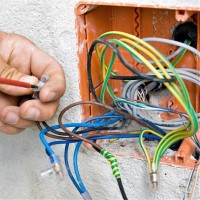 What is a vvg cable: decryption, characteristics + subtleties of cable selection
What is a vvg cable: decryption, characteristics + subtleties of cable selection 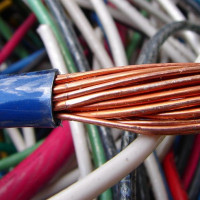 Types of cables and wires and their purpose: description and classification + decoding of marking
Types of cables and wires and their purpose: description and classification + decoding of marking 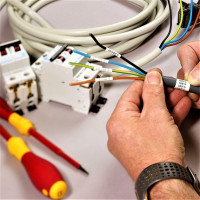 Colors of wires in electrics: standards and labeling rules + methods for determining the conductor
Colors of wires in electrics: standards and labeling rules + methods for determining the conductor 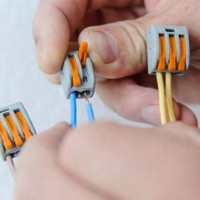 Clips for wires: existing types of clamps + detailed connection instructions
Clips for wires: existing types of clamps + detailed connection instructions  What cable to do wiring in a wooden house: types of non-combustible cable and its safe installation
What cable to do wiring in a wooden house: types of non-combustible cable and its safe installation  How much does it cost to connect gas to a private house: the price of organizing gas supply
How much does it cost to connect gas to a private house: the price of organizing gas supply  The best washing machines with dryer: model rating and customer tips
The best washing machines with dryer: model rating and customer tips  What is the color temperature of light and the nuances of choosing the temperature of the lamps to suit your needs
What is the color temperature of light and the nuances of choosing the temperature of the lamps to suit your needs  Replacement of a geyser in an apartment: replacement paperwork + basic norms and requirements
Replacement of a geyser in an apartment: replacement paperwork + basic norms and requirements
Now any wire must be checked for cross-section. Those who make cable products according to TU - greatly save on copper, and make the wires thinner than indicated.
Good afternoon, Egor.
I doubt that the manufacturers are substituted for large-scale litigation and I will explain that the actual diameter may indeed be less than the one stated on the nameplate. However, the reason is far from criminal.
I will explain - there is a paragraph in the article: “In addition, there is a standard for cross-sections and diameters that applies to round (shaped) unsealed and sealed conductive conductors of cables, wires, cords. These parameters are regulated by GOST 22483-2012. ”
This GOST regulates the conductive properties of the core at a certain temperature - there is no rigid reference to the cross section. He cited the table in the screenshot - attached after the comment.
Why did GOST developers do this? For the manufacture of conductors, the use of copper, aluminum with certain deviations in composition is allowed. Got a bad metal - the wires will be "thicker". And vice versa.